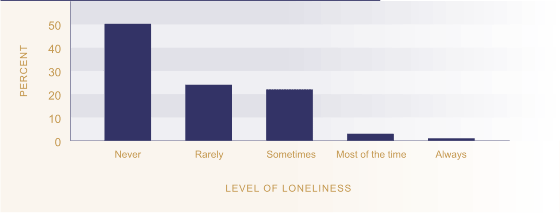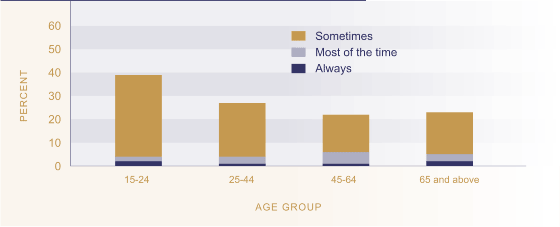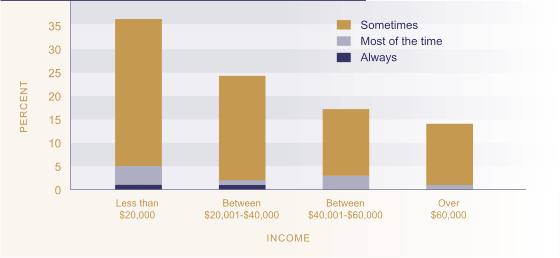Relevance
Social contact is of fundamental importance to people: humans are social creatures. Self-assessed loneliness is a proxy indicator of whether people are happy with the amount and quality of social contact that they get. As well as being an undesirable state in itself, loneliness may also contribute to poor outcomes in other areas including adverse health problems such as stress, anxiety or depression.
Current Level
In the Social Wellbeing Survey 2004, 26 percent of New Zealanders reported having felt lonely over the last twelve months. Twenty-two percent said they felt lonely 'sometimes' while a small group of people reported more frequent loneliness. Three percent said they were lonely 'most of the time' and one percent said that they 'always' feel lonely. Unemployed people and people without a partner were more likely than New Zealanders as a whole to report feeling lonely (41 percent and 37 percent respectively).
Figure SC4.1 Proportion of the population
reporting loneliness, 2004

Source: Ministry of Social
Development (2004)
Sex Differences
Overall, females (28 percent) were more likely to report having felt lonely in the last twelve months than males (24 percent). Twenty-six percent of females said they felt lonely 'rarely', compared to 22 percent of males, and 23 percent of females said they were 'sometimes' lonely, compared to 20 percent of males.
Age Differences
Loneliness is most prevalent amongst those aged 15-24. Thirty-seven percent of people in this age group experienced feelings of loneliness 'sometimes', 'often', or 'always' compared to an average of 26 percent across all age groups. The proportion of people reporting feelings of loneliness tends to decrease as age increases. Only 26 percent of those aged 25-44, 22 percent of 45-64 year olds, and 23 percent of those aged over 65 reported feeling lonely 'sometimes', 'often', or 'always'. However, even in older age groups there is a small proportion of people who report significant loneliness.
Figure SC4.2 Proportion of people
experiencing loneliness always, often or some of the time, by age, 2004

Source: Ministry of Social
Development (2004)
Ethnic Differences
About one quarter of Māori, Pakeha/European and Pacific peoples stated that they are lonely 'sometimes', 'often', or 'always' and there is little difference between these groups in overall levels of loneliness. Between 21-25 percent experience loneliness 'rarely', 19 to 20 percent are 'sometimes' lonely, and 5 percent of all three groups are lonely either 'most of the time' or 'always'. In contrast, 36 percent of people in 'other' ethnic groups (including Asians) felt lonely in the past twelve months.
Personal Income Differences
People with personal incomes of $20,000 or less reported higher rates of loneliness than people with higher incomes: 36 percent said they felt lonely 'sometimes', 'often', or 'always' in the past 12 months, compared to 24 percent of those earning $20,000 to $40,000 and 17 percent of those with incomes between $40,000 and $60,000. Only 14 percent of those whose incomes were over $60,000 indicated that they felt lonely. Of those on less than $20,000, 6 percent report being lonely 'most of the time' compared to 3 percent or less for those with incomes over $20,000.
Figure SC4.3 Proportion of people
experiencing loneliness always, often or some of the time, by income,
2004

Source: Ministry of Social
Development (2004)
